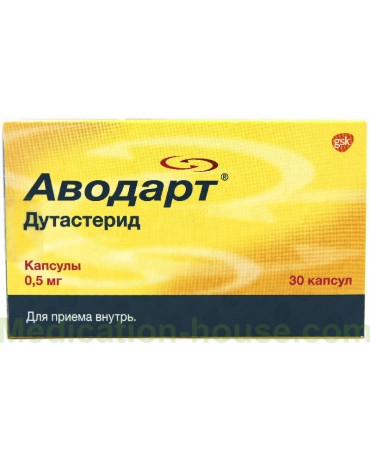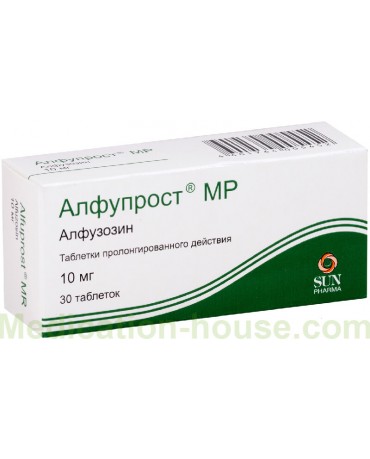Dalfaz SR instruction
You can buy Dalfaz SR on this page
Release form and composition
Dalfaz SR is available in the form of prolonged-release tablets: biconvex, round, three-layer - one white layer is located between two yellow layers of different color intensity, inclusions are allowed (10 pcs. In blisters of aluminum or polyvinyl chloride, 1 or 3 blisters in a cardboard box) ...
Active ingredient: alfuzosin (in the form of hydrochloride) - 10 mg.
Auxiliary components (layered tablet composition):
I layer: hydrogenated castor oil, hypromellose, ethylcellulose 20, aqueous colloidal silicon dioxide, dye iron oxide yellow (E172), magnesium stearate;
Layer II: alfuzosin hydrochloride, hypromellose, mannitol, microcrystalline cellulose, aqueous colloidal silicon dioxide, povidone, magnesium stearate;
Layer III: hydrogenated castor oil, hypromellose, aqueous colloidal silicon dioxide, povidone, dye iron oxide yellow (E172), magnesium stearate.
Pharmacodynamics
The active ingredient of Dalfaz SR is alfuzosin, a quinazoline derivative that is active when administered orally. It is a selective antagonist of postsynaptic alpha1-adrenergic receptors located in the prostate gland, urethra and bladder triangle.
Clinical manifestations of benign prostatic hypertrophy are expressed by infravesical obstruction of the urinary tract due to anatomical (permanent) and functional (transient) factors. The functional component of the obstruction is associated with the excitation of alpha1-adrenergic receptors, which leads to a contraction of the smooth muscles of the prostate and its membrane, the prostate urethra and the bladder triangle, as a result of which the resistance to the outflow of urine from the bladder increases and, probably, secondary instability of the bladder develops. Dalfaz SR blocks alpha1-adrenergic receptors, due to which it has a direct effect on the smooth muscles of the prostate tissue: it reduces bladder outlet obstruction, pressure in the urethra and resistance to urine outflow during urination. Thus, the drug improves the flow of urine and facilitates the emptying of the bladder. This beneficial effect of alfuzosin on urodynamics helps to reduce signs of urinary tract irritation and other symptoms caused by impaired urinary outflow in men with benign prostatic hyperplasia.
In patients with a maximum urine outflow rate (Qmax) ≤ 15 ml / sec, Dalfaz SR increases Qmax by an average of 30% after taking the first dose of the drug. In addition, with benign prostatic hypertrophy, alfuzosin contributes to a significant decrease in pressure in the detrusor of the bladder and an increase in the volume of urine that causes the urge to urinate, and also significantly reduces the volume of residual urine. These effects of the drug lead to a decrease in obstructive and irritative symptoms of benign prostatic hypertrophy.
Alfuzosin has a selective effect, therefore, when used in therapeutic doses, it practically does not affect the alpha1-adrenergic receptors of the vessels and, therefore, blood pressure (BP). Also, Dalfaz SR does not have a negative effect on the sexual function of patients.
Pharmacokinetics
In healthy middle-aged volunteers, the average value of the relative bioavailability of alfuzosin when taking prolonged-release tablets Dalfaz SR is 104.4% compared with the use of alfuzosin in an immediate release dosage form in a daily dose of 7.5 mg (2.5 mg 3 times a day ). The maximum concentration of the drug in the blood plasma is achieved within 9 hours after its administration (when using the immediate-release form - after 1 hour). According to research data, the bioavailability of alfuzosin increases if the drug is taken after meals.
The connection of alfuzosin with plasma proteins is about 90%. The drug undergoes significant metabolism in the liver, mainly with the participation of the isoenzyme CYP3A4, with the formation of pharmacologically inactive metabolites.
The half-life (T½) is 9.1 hours. It is excreted mainly in the form of metabolites (75–90%) through the intestines, 11% of unchanged alfuzosin is found in urine.
In elderly patients (over 75 years old), there are no changes in the pharmacokinetic parameters of alfuzosin in comparison with healthy middle-aged volunteers.
In patients with renal insufficiency, the mean values of Cmax (maximum plasma concentration) and AUC (area under the concentration-time curve) of alfuzosin moderately increase in comparison with individuals with normal renal function. However, this change in the pharmacokinetics of alfuzosin has no clinical significance, besides, the T½ of the drug does not change, therefore, patients with mild to moderate renal insufficiency (creatinine clearance> 30 ml / min) do not require dose adjustment of Dalfaz SR.
Indications for use
According to the instructions, Dalfaz SR is taken for the treatment of functional symptoms in benign prostatic hyperplasia. The drug is also used as an aid for catheter placement in acute urinary retention associated with benign prostatic hyperplasia.
Contraindications
Severe violations of the liver;
Renal failure with creatinine clearance less than 30 ml / min;
Orthostatic hypotension;
Intestinal obstruction (due to castor oil in the tablets);
Hypersensitivity to alfuzosin and / or other substances that make up the drug.
Dalfaz SR should be used with caution in the following cases:
Angina pectoris, coronary heart disease;
Orthostatic hypotension with clinical manifestations;
Congenital or acquired prolongation of the QT interval or the simultaneous use of drugs that increase the duration of the QT interval;
The presence in the patient's history of a pronounced hypotensive reaction to other alpha1-blockers;
Simultaneous use of antihypertensive drugs or nitrates;
Cerebral ischemia;
Combined use with inhibitors of the isoenzyme CYP3A4 (ketoconazole, ritonavir or itraconazole).
Instructions for use Dalfaz SR: method and dosage
Dalfaz SR tablets are taken orally, whole, without chewing, preferably after a meal.
Recommended dose for the treatment of functional symptoms in benign prostatic hyperplasia: 10 mg (1 tablet) daily.
Recommended dose for use as an adjunct in case of catheter placement in acute urinary retention associated with benign prostatic hyperplasia: 10 mg (1 tablet) per day, starting from the first day of catheterization. The drug is taken for 3-4 days (2-3 days during the use of the catheter and another 1 day after its removal).
Side effects
Gastrointestinal tract: dry mouth, epigastric pain, nausea, diarrhea;
Cardiovascular system: orthostatic hypotension, tachycardia; in patients with ischemic heart disease - exacerbation of symptoms of angina pectoris;
Central nervous system (CNS): dizziness, headache, weakness, drowsiness, fainting, asthenic syndrome, syncope;
Allergic reactions: skin rash, itching;
Others: flushing of the skin, edema.
Overdose
Symptoms of an overdose of Dalfaz SR are reflex tachycardia and an excessive decrease in blood pressure (BP).
If signs of overdose appear, the patient should be hospitalized. It is necessary to carry out constant monitoring of blood pressure, placing the patient in a horizontal position. With a decrease in blood pressure, the introduction of plasma substitutes (in order to increase the volume of circulating blood) and vasoconstrictors is indicated. After the elimination of hypotension (restoration of blood pressure), blood pressure control must be continued for another day.
The high degree of binding to plasma proteins causes poor elimination of alfuzosin by hemodialysis.
Special instructions
In some people, especially in patients receiving antihypertensive treatment, for several hours after taking Dalfaz SR, like other α1-adrenergic receptor blockers, postural hypotension may develop with or without symptoms (fatigue, dizziness, sweating). The patient should be in a horizontal position until the symptoms disappear completely. Such phenomena are usually temporary and occur only at the beginning of treatment; they have no effect on the continuation of therapy, but the patient must be warned about them.
Patients with coronary insufficiency are not recommended to prescribe alfuzosin as monotherapy. Treatment of coronary insufficiency should be continued, and alfuzosin should be discontinued if angina returns or worsens.
Patients should be advised that the tablets must be swallowed whole. They should not be bitten, chewed, crushed, ground into powder, since such actions can cause inappropriate release and absorption of the active substance, which can lead to the rapid development of side effects.
Influence on the ability to drive vehicles and complex mechanisms
When driving vehicles and engaging in activities that require an increased concentration of attention and a high reaction rate, special care should be taken due to side effects of Dalfaz SR, such as dizziness, asthenia, visual impairment, which occur mainly at the beginning of therapy.
Application during pregnancy and lactation
Dalfaz SR is not intended for women.
Childhood use
The drug is not used in pediatric practice (for the treatment of children and adolescents under the age of 18).
With impaired renal function
Dalfaz SR is contraindicated in severe renal failure (with creatinine clearance <30 ml / min). Patients with mild to moderate renal impairment (with creatinine clearance> 30 ml / min) do not require dose adjustment.
For violations of liver function
Dalfaz SR is prohibited to use if the patient has concomitant severe hepatic dysfunction.
Use in the elderly
In patients over the age of 75, the drug should be used with caution.
Drug interactions
It is not recommended to take Dalfaz SR in combination with α1-receptor blockers (prazosin, minoxidil, urapidil), this can lead to an increase in the hypotensive effect and cause the development of severe postural hypotension.
In the case of taking alfuzosin with antihypertensive drugs, it is possible to increase the hypotensive effect and the risk of postural hypotension (additive effect).
When using Dalfaz SR with inhibitors of the CYP3A4 system (ketoconazole, ritonavir, itraconazole), an increase in the concentration of alfuzosin in the blood is likely.
Terms and conditions of storage
Store in a dry, dark place, out of the reach of children, at a temperature not exceeding 25 ° C.
Shelf life is 3 years.
Reviews about Dalfaz SR
Reviews about Dalfaz SR are contradictory. Some patients note that the drug improves urine flow and facilitates the emptying of the bladder, thereby reducing the number of nocturnal urges to urinate, improving erectile function and overall condition. Other men write about the lack of effect even after several weeks of admission.
Terms of sell
You don't need a prescription to buy Dalfaz SR.




